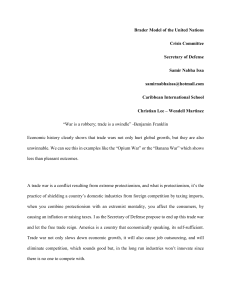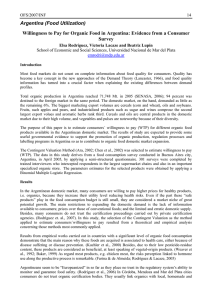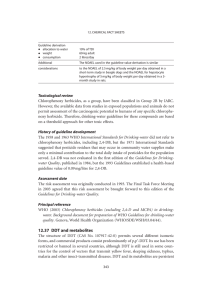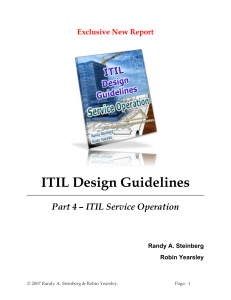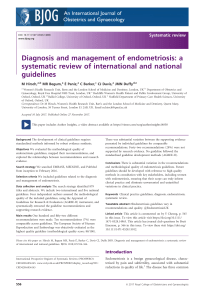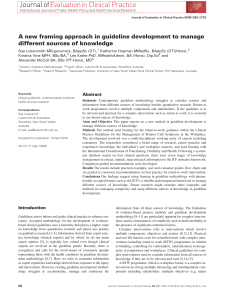Guidelines for imports of organic products 15 12 2008
Anuncio
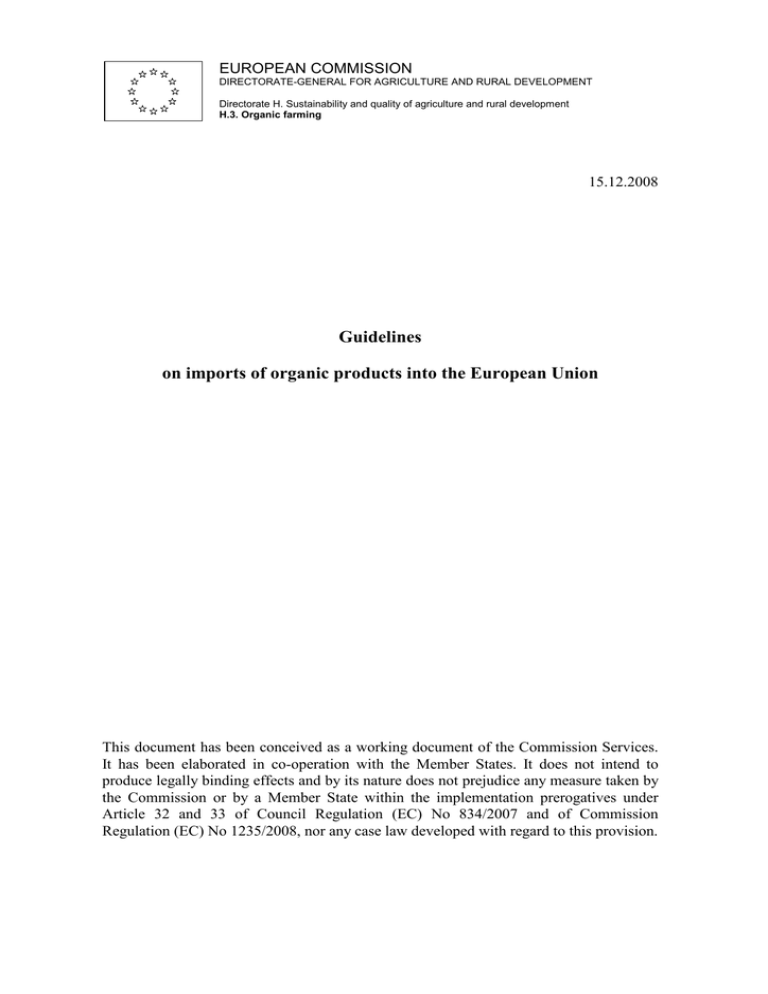
EUROPEAN COMMISSION DIRECTORATE-GENERAL FOR AGRICULTURE AND RURAL DEVELOPMENT Directorate H. Sustainability and quality of agriculture and rural development H.3. Organic farming 15.12.2008 Guidelines on imports of organic products into the European Union This document has been conceived as a working document of the Commission Services. It has been elaborated in co-operation with the Member States. It does not intend to produce legally binding effects and by its nature does not prejudice any measure taken by the Commission or by a Member State within the implementation prerogatives under Article 32 and 33 of Council Regulation (EC) No 834/2007 and of Commission Regulation (EC) No 1235/2008, nor any case law developed with regard to this provision. Guidelines on imports of organic products into the European Union (1) Guideline for the content of the lists to be published (2) Guideline for the requests for inclusion (3) Guideline for the initial assessment report for a control body or control authority for the purpose of compliance (4) Guideline for the initial assessment report for a control body or control authority for the purpose of equivalence (5) Guideline for the notification to a third country authority (6) Guideline for annual reports, including further assessment reports (7) Guideline for the assessment of equivalence (8) Guideline for group certification (9) Guideline for the list of operators and communication (10) Guideline for the management of irregularities and infringements (11) Guidelines for verification of incoming consignments by customs or other authorities Abbreviations used: CB Control Body CA Control Authority AB Assessment Body Guidelines on imports of organic products to the European Union – version 2008/12 – page 2 1. Guideline for the content of the lists to be published Articles 3, 7 and 10 of Commission Regulation (EC) No 1235/2008 A. Product categories Only general categories to be indicated: plant products or livestock products. In special cases, more specific product categories can be given. B. Code numbers for CBs and CAs (1) CAs and CBs for the purpose of compliance (article 3): the Commission will attribute a code number. (2) CAs and CBs referred to in the list of recognised third countries (article 7): the third country will provide a code number for each CB and CA. (3) CAs and CBs for the purpose of equivalence (article 10): the CA or CB will propose a code number and the Commission will attribute it. For CBs and CAs that figure on several lists, code numbers will be proposed that identify the CB or CA without any doubt and do not lead to confusion. C. Duration of the inclusion in the list In order to synchronise the commonly used accreditation cycle of 4 or 5 years, the duration of the inclusion in the list shall normally be set at 5 years. Guidelines on imports of organic products to the European Union – version 2008/12 – page 3 2. Guideline for the requests for inclusion Articles 4, 8, 11, 19. A. Language of the request Preferably agreed with the Commission in advance. B. Format of the request 1. CB or CA for compliance (Article 4): form, see template below 2. Third country (Article 8): no form, official letter from country representative to European Commission 3. CB or CA for equivalence (Article 11): form, see template below 4. Import authorisation Member State (Article 19): existing form for article 11(6) of Regulation 2092/91, a version adapted to article 19 of Regulation 1235/2008 is made available separately. Guidelines on imports of organic products to the European Union – version 2008/12 – page 4 Form Request for recognition of a Control Body or Control Authority for the purpose of compliance as referred to in Article 32 of Council Regulation (EC) No 834/2007 1. Identification Name of Control Body/Control Authority1 Head Office address (postal address, phone, fax, e-mail, website) Other offices addresses (postal address, phone, fax, e-mail, website) and description of the activities of each office Internet website where the list of operators subject to the control system can be found Contact point where information is readily available on the certification status of operators, product categories concerned as well as suspended and decertified operators and products 2. Geographical scope and related product categories List of third countries in which the control body or control authority has its activities and for which it requests recognition. Indicate the product categories for each third country. 3. Technical dossier See article 4(3) of Commission Regulation 1235/2008: to be attached Name of the accreditation body contracted to produce the assessment reports referred to in Article 32(2) of Regulation 834/2007: Current accreditation and duration: 4. Authentication Signature, name, position Date Stamp 1 Delete what is not appropriate Guidelines on imports of organic products to the European Union – version 2008/12 – page 5 Form Request for recognition of a Control Body or Control Authority for the purpose of equivalence as referred to in Article 33 of Council Regulation (EC) No 834/2007 1. Identification Name of Control Body/Control Authority2 Head Office address (postal address, phone, fax, e-mail, website) Other offices addresses (postal address, phone, fax, e-mail, website) and description of the activities of each office Internet website where the list of operators subject to the control system can be found Contact point where information is readily available on the certification status of operators, product categories concerned as well as suspended and decertified operators and products 2. Geographical scope and related product categories List of third countries in which the control body or control authority has its activities and for which it requests recognition. Indicate the product categories for each third country. 3. Technical dossier See article 11(3) of Commission Regulation 1235/2008: to be attached Name of the assessment body contracted to produce the assessment reports referred to in Article 33(3) of Regulation 834/2007: Current accreditation and its duration: 4. Authentication Signature, name, position Date Stamp 2 Delete what is not appropriate Guidelines on imports of organic products to the European Union – version 2008/12 – page 6 3. Guideline for the initial assessment report on control bodies and control authorities for the purpose of compliance Article 4.3 (c) The assessment report can be written by: - competent authorities (either of the third country concerned, or of a Member State); - a national accreditation body with competence in organic agriculture - an international supervisory or accreditation body that is specialised in organic agriculture In these guidelines, the term “Assessment Bodies” (ABs) will be used for all three types of bodies drawing up the assessment report. Assessment Bodies shall demonstrate that they fulfil the requirements of ISO 170113, for example by peer review. They shall be prepared to undergo peer review. They shall demonstrate that their staff involved in assessing the control bodies and authorities have sufficient knowledge, qualification, training and experience with respect to organic agriculture in general and with the relevant EU regulation in particular. Assessment Bodies are encouraged to undertake common evaluations and to write common assessment reports. They are also encouraged to draw up Codes of Good Practice and to communicate these to the Commission. The initial assessment report shall demonstrate in-depth knowledge of EU regulations and describe how the requirements of the EC regulation are met in detail. No exceptions or interpretations can be made. Group certification can not be accepted. A seed database needs to be set up. Exceptional rules can only be applied if they are clearly described in the new implementing rules as applying to all Member States and when the conditions for applying the exceptions are fulfilled. The initial assessment report shall evaluate the operational performance of the control body or control authority; it shall therefore include: (1) a report on the document review of the relevant general documents describing the structure, functioning and quality management of the CB or CA. (2) a report of the office audit of the office where the relevant documents are kept and certification decisions are made, including (a) 3 the result of the checking of operator files and verification of handling of non-conformities and complaints, including the use of unannounced and follow-up visits, the sampling policy and the exchange of information with other CBs and CAs; ISO/IEC Guide 17011:2004: Conformity Assessment: General Requirements for accreditation bodies accrediting conformity assessment bodies Guidelines on imports of organic products to the European Union – version 2008/12 – page 7 (b) an evaluation of the knowledge, qualification, training and experience of the staff with respect to organic agriculture in general and with the relevant EU regulations in particular (c) the conclusions from interviews with control and certification staff (3) similar reports of office audits in critical locations, i.e. locations where activities of a control body or control authority are conducted that determine or demonstrate its effectiveness (4) The report and conclusions on a suitably proportionate number of visits to representative4 operators to carry out review audits5 and/or witness audits6. These visits shall be carried out in a number of third countries that is proportional to the number of third countries in which the CB or CA has control activities, and including third countries in which it has offices and third countries in which it has control activities but no offices. (5) an evaluation of the knowledge of local conditions and languages The report shall have a geographical scope that reflects the geographical scope of the accreditation or of the Competent Authority approval. 4 Representative as regards type of production, range of inspection, size of operations and location of operators under the control of the CB or CA. Representative is to be understood also as sufficiently diversified. 5 Review audit: inspection of an operator by the assessor to verify compliance with the operating procedures of the CB or CA and to verify its effectiveness 6 Witness audit: observation by the assessor of an inspection by an inspector of the CB or CA Guidelines on imports of organic products to the European Union – version 2008/12 – page 8 4. Guideline for the initial assessment report on control bodies and control authorities for the purpose of equivalence Article 11.3 (c) The assessment report can be written by: - competent authorities (either of the third country concerned, or of a Member State); - a national accreditation body with competence in organic agriculture; or - an international supervisory or accreditation body that is specialised in organic agriculture. In these guidelines, the term “Assessment Bodies” (ABs) will be used for all three types of bodies drawing up the assessment report. Assessment Bodies shall demonstrate that they fulfil the requirements of ISO 170117, for example by peer review. They shall be prepared to undergo peer review. They shall demonstrate that their staff involved in assessing the control bodies and authorities have sufficient knowledge, qualification, training and experience with respect to organic agriculture in general and with the relevant organic standards in particular. Assessment Bodies are encouraged to undertake common evaluations and to write common assessment reports. They are also encouraged to draw up Codes of Good Practice and to communicate these to the Commission. The initial assessment report shall include a detailed assessment of the equivalence of the standards applied with the production standards contained in Titles III and IV of Regulation 834/20078 and on the equivalence of the control measures applied with those referred to in Title V of Regulation 834/2007. The initial assessment report shall evaluate the operational performance of the control body or control authority; it shall therefore include: (1) a report on the document review of the relevant general documents describing the structure, functioning and quality management of the CB or CA. (2) a report of the office audit of the office where the relevant documents are kept and certification decisions are made, including (a) the result of the checking of operator files and verification of handling of non-conformities and complaints, including the use of unannounced and follow-up visits; 7 ISO/IEC Guide 17011:2004: Conformity Assessment: General Requirements for accreditation bodies accrediting conformity assessment bodies 8 Any reference to Regulation 834/2007 shall be read and understood as a reference to Regulation and all the implementing Commission Regulations that refer to it: Regulation 889/2008, Regulation xxxx/2008 and future regulations. Guidelines on imports of organic products to the European Union – version 2008/12 – page 9 (b) an evaluation of the knowledge, qualification, training and experience of the staff with respect to organic agriculture in general and with the relevant EU regulations in particular (c) the conclusions from interviews with control and certification staff (3) similar reports of office audits in critical locations, i.e. locations where activities of a control body or control authority are conducted that determine or demonstrate its effectiveness (4) The report and conclusions on a representative number of visits to representative9 operators to carry out review audits10 and/or witness audits11. These visits shall be carried out in a several third countries, the number of which being proportional to the number of third countries in which the CB or CA has control activities. The visits shall include third countries in which it has offices and third countries in which it has no offices. (5) an evaluation of the knowledge of local conditions and languages for each third country concerned The report shall have a geographical scope that reflects the geographical scope of the accreditation or of the Competent Authority approval. 9 10 11 Representative as regards type of production, range of inspection, size of operations and location of operators under the control of the CB or CA. Representative is to be understood also as sufficiently diversified. Review audit: inspection of an operator by the assessor to verify compliance with the operating procedures of the CB or CA and to verify its effectiveness Witness audit: observation by the assessor of an inspection by an inspector of the CB or CA Guidelines on imports of organic products to the European Union – version 2008/12 – page 10 5. Guideline for the notification to a third country authority Article 4.3 (d) and 11.3 (d)) The CB or CA sends a letter to authorities of the third country presenting itself and its control activities in the third country. Signed declaration by CB or CA that it will respects the legal requirements imposed on it by the authorities of the third country concerned. Guidelines on imports of organic products to the European Union – version 2008/12 – page 11 6. Guideline for the annual report 6.1 Annual report by control bodies and control authorities Articles 5 and 12 As set out in Articles 5(1)(c) and 12(1)(b), the annual report updates both the original technical dossier and the initial assessment report. A. Update of information in the technical dossier: (1) control activities carried out in each third country during the previous year (2) results obtained, irregularities and infringements observed and the corrective actions taken (3) changes in the production standards and control measures applied (4) other relevant changes B. Update of the assessment report The assessment report shall contain the results of the on-the-spot evaluations, surveillance and multi-annual re-assessment by the assessment body. The frequency, the geographical distribution and content of the activities shall be in line with the principles set out in guidelines 3 and 4 on the initial assessment report. 6.2 Annual report by third countries Article 9 The content of the reports is set out in the article. Format: free Guidelines on imports of organic products to the European Union – version 2008/12 – page 12 7. Guideline for the assessment of equivalence Articles 8 (2) (c) and (d) and 11 (3) (b) Definition of equivalence: Regulation 834/2007, Article 2(x): 'equivalent', in describing different systems or measures, means that they are capable of meeting the same objectives and principles by applying rules which ensure the same level of assurance of conformity. 1. The objectives and the principles of organic production as reflected in the evaluated standard, including directly related and relevant legal requirements, should be compared with those in the base standard, i.e. Regulation 834/2007 and Regulation 889/2008. 2. A side-by-side comparison of the relevant12 requirements as reflected in the full technical standards should be carried out. Alternatively, the base standard, including the control measures, should be summarised into essential, short, plain language requirements. The assessors of the evaluated standard should then indicate whether it has an equivalent approach that matches that requirement and refer to (but not copy) the elements in the technical or legal text where the evaluators can verify them. 3. From this comparison, an inventory should be made of the substantial differences between the two standards. In resolving these outstanding issues, the international standard, i.e. Codex Alimentarius Guidelines CAC/GL 32, should be taken into account and, as regards control and certification issues, it is recommended to use relevant international best practices guidelines13. 4. The result of the equivalence assessment should be made public by the Assessment Body that carried out the assessment. 5. Assessments that use Regulation 2092/91 as their basis and already existing before 1 January 2009 can be used until 31 December 2009. The use and further development of an internationally accepted "best practice" methodological guidelines14 for assessing equivalency is recommended. 12 Example: if the evaluated standard only deals with plant production, the comparison should not look at livestock standards. 13 Such as "International Requirements for Organic Certification Bodies", UNCTAD, FAO, IFOAM, October 2008 14 Such as Codex Alimentarius Guidelines CAC/GL 34: Guidelines for the Development of Equivalence Agreements Regarding Food import and Export Inspection and Certification Systems, and "Guide for assessing equivalence of organic standards and technical regulations", UNCTAD, FAO, IFOAM, October 2008 Guidelines on imports of organic products to the European Union – version 2008/12 – page 13 8. Guidelines for the evaluation of the equivalence of organic producer group certification schemes applied in developing countries15 A. Objectives of a group certification system 1. To overcome the economic difficulties in relation to the control of small operators in developing countries (as defined by OECD16). B. Principle 2. A substantial part of the inspection work is carried out by internal inspectors in the framework of the internal control system set up by the group. 3. The external control body verifies and evaluates the effectiveness of the internal control system and certifies the group as a whole. C. Scope: who can be considered as a group? 4. In principle only small farmers can be members of the group covered by group certification. Larger farms (i.e. farms bearing an external certification cost that is lower than 2 % of their turnover) can also belong to the group but have to be inspected annually by the external inspection body. Processors and exporters can be part of the structure of the group, but have to be inspected annually by the external inspection body. 5. The farmers of the group must apply similar production systems and the farms should be in geographical proximity. 6. A group may be organised on itself, i.e. as a co-operative, or as a structured group of producers affiliated to a processor or an exporter. 7. The group must be established formally, based on written agreements with its members. It shall have central management, established decision procedures and legal capacity. 8. When intended for export, the marketing of the products must be carried out as a group. D. The internal control system 9. The internal control system of the group is a documented internal quality system that includes a contractual arrangement with each individual member of the group. 15 This guideline was formerly published as Commission services guidance document on 6 November 2003 16 http://www.oecd.org : DAC list of ODA Recipients Guidelines on imports of organic products to the European Union – version 2008/12 – page 14 10. Internal inspectors are designated by the group and carry out internal controls. They must receive suitable training. The internal quality system sets out rules to avoid or limit potential conflicts of interest of the internal inspectors. 11. The internal inspectors carry out at least one annual inspection visit to each individual operator including visits to fields and facilities. 12. The internal control system keeps appropriate documentation including at least a description of the farms and the facilities, the production plans, the products harvested, the contractual arrangement with each individual member and internal inspection reports. 13. The internal control system shall include the application of sanctions to individual members who do not comply with the production standards. It shall inform the external inspection body of the irregularities and non-compliances found, as well as of the corrective actions imposed with agreed time for completion. E. The external control body 14. The external control body evaluates the effectiveness of the internal control system, with the final aim to assess compliance with the production standards by all individual operators. 15. It has a contractual agreement with the group 16. It carries out at least one annual inspection of the group. The inspection shall include an inspection visit of a number of individual farms with the aim to inspect for compliance with the standards and to evaluate the effectiveness of the internal control system. 17. Each year the external control body shall define and justify a risk-orientated sample of farms subject to their annual inspections. The number of farms subject to annual external inspection shall in any case not be lower than 10. For a normal risk situation, it shall not be lower than the square root of the number of farms in the group. For medium or high-risk situations, the external inspection bodies shall define a risk factor of at least 1.2 to 1.4 respectively. The farms visited by the external inspection body must be predominantly different from one year to the other. Minimum number of farms to be inspected by the external inspection body Number of group members = n Minimum n Normal risk factor 1 Medium risk factor 1.2 High risk factor 1.4 10 12 14 1.2 square root of n 1.4 square root of n Square root of n Factors to define the risk should include: Guidelines on imports of organic products to the European Union – version 2008/12 – page 15 a) factors related to the magnitude of the farms – size of the holdings – value of the products – difference in value between the organic and the conventional products b) factors related to the characteristics of the holdings – degree of similarity of the production systems and the crops within the group – risks for intermingling and/or contamination c) experience gained – number of years the group has functioned – number of new members registered yearly – nature of the problems encountered during controls in previous years and results of previous evaluations of the effectiveness of the internal control system – management of potential conflicts of interest of the internal inspectors – staff turnover. 18. Larger farms, processors and exporters shall be inspected annually by the external control body. 19. In case the external control body finds the internal control system to seriously lack reliability and effectiveness, it shall increase the number of farms subject to their annual inspection to at least three times the square root of the number of farms in the group. 20. The external control body shall have a documented sanctions policy vis-à-vis groups. In cases it finds the internal control system to lack reliability and effectiveness, the external inspection body shall apply sanctions to the group as a whole, including, in case of serious deficiencies, the withdrawal of the certification of the group. 21. In their report to the relevant supervising authorities, the external control body shall refer to all the elements of this guidance document. Guidelines on imports of organic products to the European Union – version 2008/12 – page 16 9. Guideline for publication of list of operators Articles 3 (2) (e) and 10 (2) (e) 1. The website shall contain all operators subject to control, at least with respect to export to the European Union. 2. It shall contain for each operator the name, the third country of operation, the location, the type of products and the certification status (organic or in-conversion). 3. It shall also contain a contact point for further information. 4. The following categories of production shall be mentioned for each operator: primary production, processing or exporter. 5. Decertified products and suspended operators shall be indicated, for the time period relevant to the decertification or suspension. In-conversion products shall clearly be indicated as such. 6. The website shall be accessible to all who is requesting access. 7. The website shall be regularly17 updated; the date of the last update shall be mentioned. 8. Requests from recognised control authorities and control bodies or from listed competent authorities to CBs or CAs regarding the certification status of certain products shall be replied to within two working days. 17 For instance not later than 2 weeks after a decision has been taken and not later than two days after a decision of decertification of an operator has been taken Guidelines on imports of organic products to the European Union – version 2008/12 – page 17 10. Guideline for the management of and communication on irregularities and infringements concerning imported products 1. When receiving imported organic products, the importer has to check the products and the related documents (see Article 34 of Regulation 889/2008). In case of doubt, he shall immediately inform the CB or CA (see Article 91 of Regulation 889/2008). 2. The Control Body or Control Authority reports the irregularities and infringements found relating to products imported or destined for importation to the CB or CA of the exporter and copies this report to the AB of the CB or CA of the exporter. It also immediately reports these irregularities and infringements to the competent authority of the Member State where the importer has notified its activities, in order to inform the other Member States that rejected goods may be presented for import into their territory. 3. When the product originates in a listed third country, the Member State notifies the case to the Commission. The Commission contacts the third country with a request for investigation. It keeps the co-reporting Member States nominated for that third country informed and asks for their assistance where appropriate. 4. When the product originates in a third country not listed, the Member State notifies the case to the Commission. The Commission contacts the CB or CA in question with a request for investigation or for corrective measures and copies the request to the AB concerned. It keeps the co-reporting Member States nominated for that CB or CA informed and asks for their assistance where appropriate. 5. The ABs shall investigate the irregularities and infringements relating to the CAs or CBs they have assessed and of which they are informed in the framework of their surveillance and multi-annual re-assessment activities. 6. For the transitional system of member state import authorisations, there are no changes and the system is described in Article 19 (1) to 19 (3) of Regulation 11235/2008. 7. Requests from recognised CBs and CAs or from listed competent authorities to CBs or CAs regarding suspicion of fraud or infringements shall be replied to within two working days. Guidelines on imports of organic products to the European Union – version 2008/12 – page 18 11. Guidelines for verification of incoming consignments by customs or other authorities Guidelines under preparation, especially with regard to recognising organic products imported according to article 32 of Regulation 834/2007 as such. Guidelines on imports of organic products to the European Union – version 2008/12 – page 19
